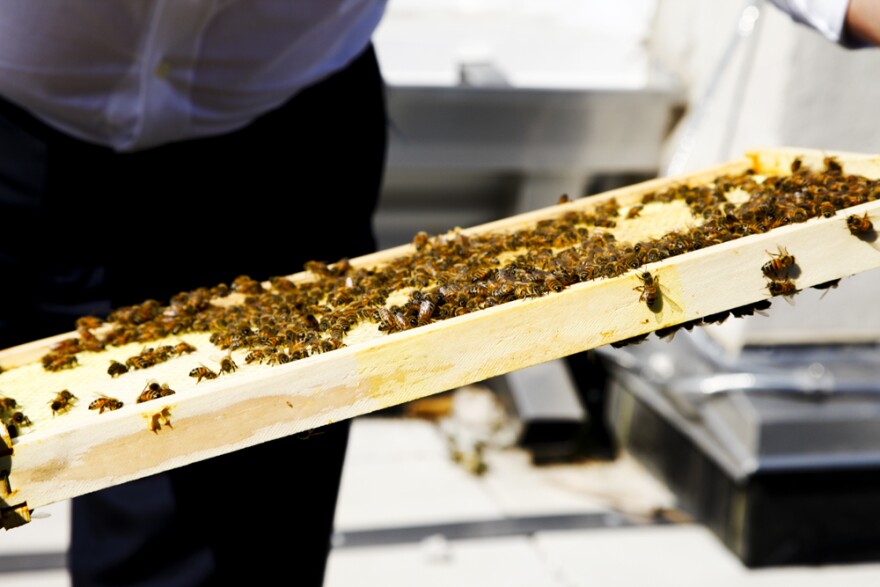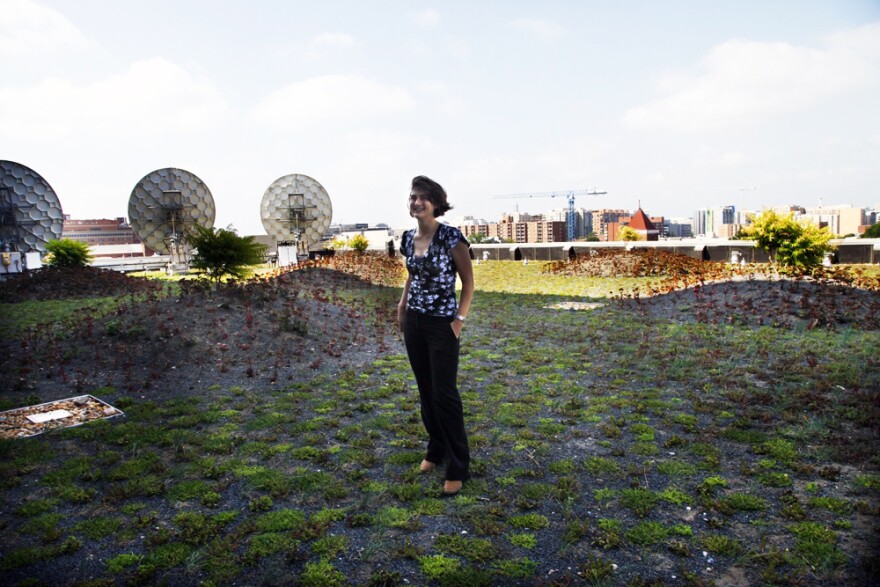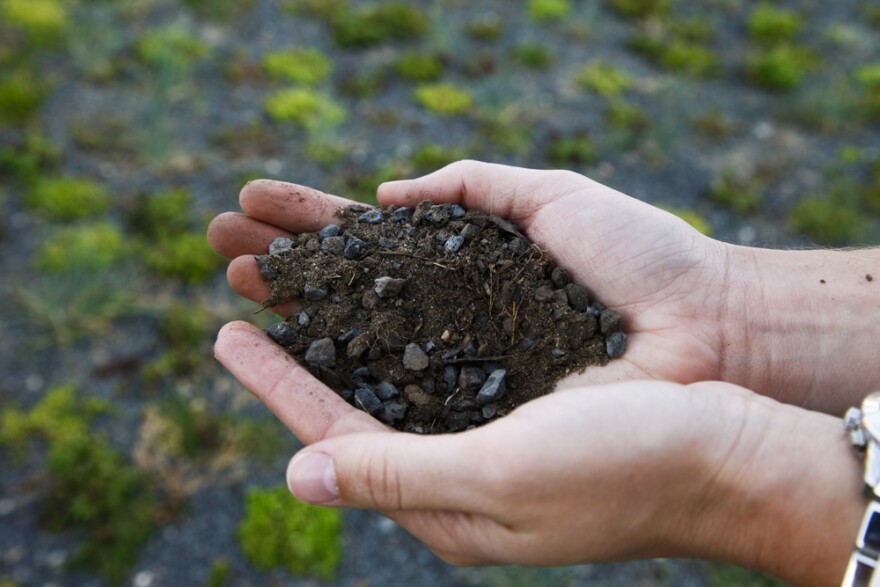Shortly after NPR's busy staff moved into the new headquarters building at 1111 North Capitol Street, another, equally busy team, got settled on the roof. While they don't benefit from the space's state-of-the-art studio equipment and collaborative working spaces, they do appreciate the sunshine and sugar syrup. Frankly, they find the whole arrangement pretty sweet.
That's because they're honeybees.
The NPR headquarters features 32,500 square feet of green roof, which serves as home to a variety of plants, several satellite dishes and a set of beehives. The bees arrived in May and very quickly captured staff attention and hearts. They're a favorite stop on the visitors' tour and even inspired a Twitter account, @NPRBees.
Maury Schlesinger, NPR's director of real estate and administrative services, was instrumental in arranging the NPR green roof as a home for these bees. A colleague put him in contact with Georgetown Honeybee Company's Jeff Miller.
"It just seemed like a cool idea," Schlesinger says. "It was not complicated and not expensive."

Despite a significant setback at the beginning – one of the queen bees arrived dead and had to be replaced – the colonies look healthy and strong. Right now, Miller estimates there are between 30-40,000 bees living in the hives.
"These guys are in great shape. Just where I want them to be," Miller says.
However, he is already preparing for colder months ahead.
"You want to make sure they have about 40 pounds of sugar to get them through winter."
Since these hives are in their first year and still getting established, Miller stops by about every two weeks to feed them sugar syrup and a protein supplement called "pollen patties."

"Once it gets below 50 degrees we have to stop feeding, them and they're on their own. The syrup gets too cold to eat," he says. "The bees also stop flying and stay in the hive."
No matter what he does, a portion of the bees will die during winter. But Miller says if 10 thousand bees survive the winter, then NPR should have between 40 to 50 thousand bees on its roof next year. "In the spring, we'll add additional boxes on top of these that they'll use to deposit the honey and they'll keep their young in the lower boxes."
The bees will start producing honey next spring and are expected to yield about 60 pounds (or about five gallons) of honey per hive. Miller will get half of the honey in return for caring for the bees, and NPR plans to distribute a small amount to visitors next year.
The NPR bees also help to pollinate plants in the surrounding neighborhood, traveling up to three miles from the hive.
"Bees need two million blossoms to make a pound of honey," Miller says. "They feed off the green roof [at NPR], but it's not enough. They have to travel."
Still, the NPR roof makes an ideal home for the bees. The hives are located on a particularly sunny section of the green roof, which is perfect according to Miller. "They like the sun."
A Bee-utiful Green Roof
Just as the bees like the roof, the green roof likes the bees.
"The bees help [the green roof] a lot," says Erin Stamer, a project manager at Prospect Waterproofing Company, the group that installed and cares for NPR's green roof. "Some of the plants spread through seed and the bees aid in that through pollination."

Higher elevation, direct sun and minimal shade all make this rooftop a completely different environment than the ground below, Stamer says. Here, all the plants have to be able to store water and survive long periods without rain.
Most of the plants on the green roof are sedums, which are drought-tolerant plants with water-retaining leaves. There are also wild spring onions.
"On this roof there are different varieties, a mix of ground covers and accent plants," Stamer says.
The majority of the plants on the roof are placed in about four inches of "growing media," largely made up of expanded shale and sand. This soil doesn't have a lot of organic matter like you would find in regular soil.

"Regular soil compacts, holds too much water and would clog the roof drains," says Stamer. Engineered media doesn't compact, so it stays at four inches, or at the depth you place on the roof. It's lightweight to minimize the extra pressure on the structure.
The green roof is expected to last more than 20 years and actually helps protect the roofing and waterproofing material underneath it. As a benefit, the upkeep is very manageable.
"I come out here with a crew and we'll hand weed throughout the growing season and install fertilizer if needed," Stamer says. "In the first year, we'll come out every month or so, but as the years go on it becomes less and less." Eventually the green roof will only require quarterly care.
The green roof sits on top of portions of the building's fourth floor and the top floor as well, so the changing and growing plants on the green roof can be seen from two sides of the upper floors.
"The landscape architect picked [the plants] so there would be a variety of colors over the seasons," says Schlesinger, who also helped coordinate the roof installation. "It will be an active roof garden."

Stamer adds, "The growing season is spring through the fall. Going into winter the plants go dormant. Some will shrink back in on themselves, some will lose leaves, and some will change colors. They do that in the harsh summer heat and droughts too."
With each season bringing something new to observe, the roof has already become an attractive addition to the building.
"This one is looking fantastic," she says. "The plants are growing really well. They were planted last fall, so it has almost been a full year and they are already covering more than 70% of the roof."
Besides providing an attractive view and a home to the bees, the green roof helps with storm water management and water quality by filtering rainwater. It also helps to mitigate the urban heat island effect by providing more green space and contributing to a cooler city at large, she says.
"We need spaces for ourselves, so why not replace the land we take a way with land on top of buildings?" says Stamer.
We suspect the bees would agree.
Copyright 2021 NPR. To see more, visit https://www.npr.org. 9(MDA4NjIwNTkwMDEzMjI4NDY0MjY4ZTBlNA004))


